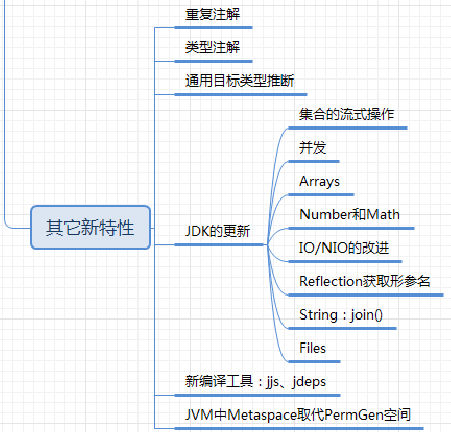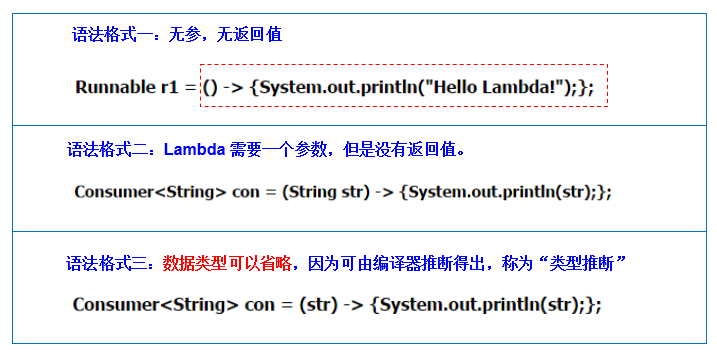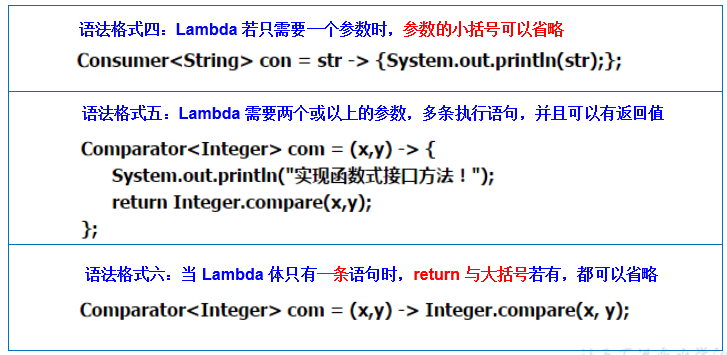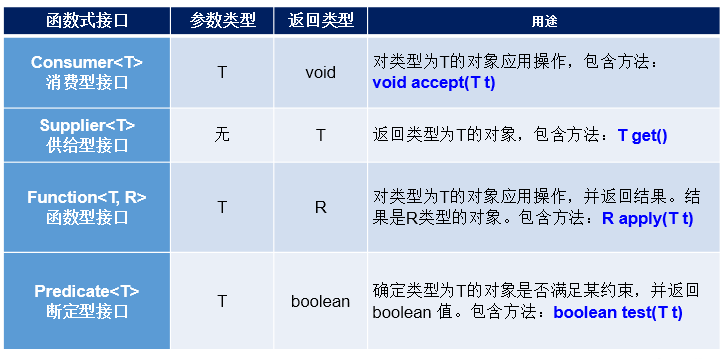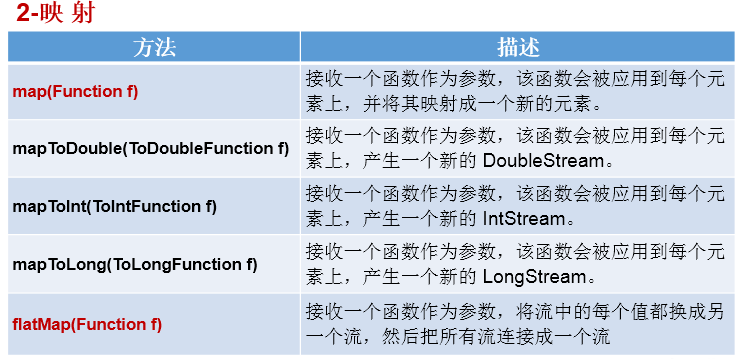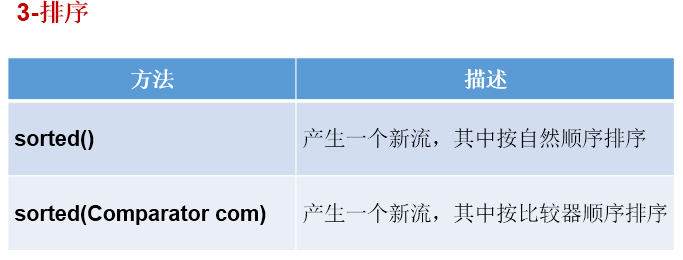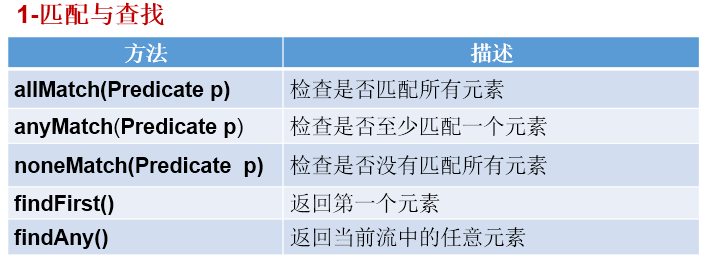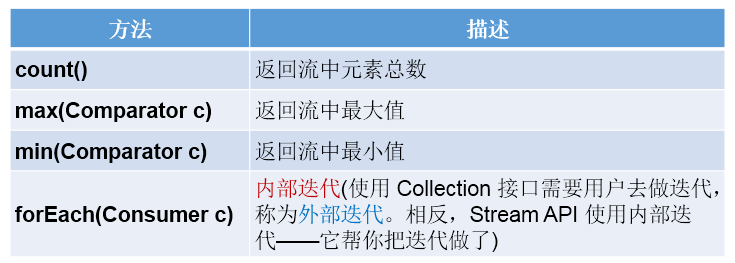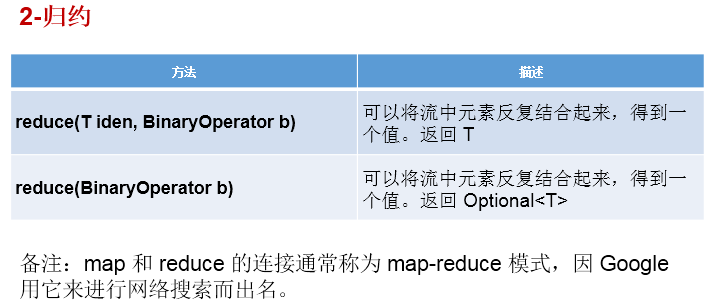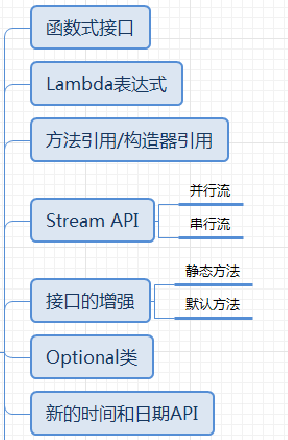java8的其他新特性 [TOC]
Java8新特性概述
Lambda表达式 1.Lambda表达式使用前后的对比: 举例一: 1 2 3 4 5 6 7 8 9 10 11 12 13 14 15 16 17 18 19 @Test public void test1 () Runnable r1 = new Runnable() { @Override public void run () System.out.println("我爱北京天安门" ); } }; r1.run(); System.out.println("***********************" ); Runnable r2 = () -> System.out.println("我爱北京故宫" ); r2.run(); }
举例二: 1 2 3 4 5 6 7 8 9 10 11 12 13 14 15 16 17 18 19 20 21 22 23 24 25 26 27 28 29 @Test public void test2 () Comparator<Integer> com1 = new Comparator<Integer>() { @Override public int compare (Integer o1, Integer o2) return Integer.compare(o1,o2); } }; int compare1 = com1.compare(12 ,21 ); System.out.println(compare1); System.out.println("***********************" ); Comparator<Integer> com2 = (o1,o2) -> Integer.compare(o1,o2); int compare2 = com2.compare(32 ,21 ); System.out.println(compare2); System.out.println("***********************" ); Comparator<Integer> com3 = Integer :: compare; int compare3 = com3.compare(32 ,21 ); System.out.println(compare3); }
2.Lambda表达式的基本语法:
3.如何使用:分为六种情况
总结六种情况: ->左边:lambda形参列表的参数类型可以省略(类型推断);如果lambda形参列表只一个参数,其一对()也可以省略
函数式接口 1.函数式接口的使用说明
如果一个接口中,只声明了一个抽象方法,则此接口就称为函数式接口。
2.Java8中关于Lambda表达式提供的4个基本的函数式接口: 具体使用:
3.总结 3.1 何时使用lambda表达式? 当需要对一个函数式接口实例化的时候,可以使用lambda表达式。
3.2 何时使用给定的函数式接口? 如果我们开发中需要定义一个函数式接口,首先看看在已有的jdk提供的函数式接口是否提供了
方法引用 1.理解: 方法引用可以看做是Lambda表达式深层次的表达。换句话说,方法引用就是Lambda表达式,也就是函数式接口的一个实例,通过方法的名字来指向一个方法。
2.使用情境: 当要传递给Lambda体的操作,已经实现的方法了,可以使用方法引用!
3.格式: 类(或对象) :: 方法名
4.分为如下的三种情况:
情况1 对象 :: 非静态方法
情况2 类 :: 静态方法
情况3 类 :: 非静态方法
5.要求:
要求接口中的抽象方法的形参列表和返回值类型与方法引用的方法的形参列表和返回值类型相同!(针对于情况1和情况2)
6.使用建议: 如果给函数式接口提供实例,恰好满足方法引用的使用情境,大家就可以考虑使用方法引用给函数式接口提供实例。如果大家不熟悉方法引用,那么还可以使用lambda表达式。
7.使用举例: 1 2 3 4 5 6 7 8 9 10 11 12 13 14 15 16 17 18 19 20 21 22 23 24 25 26 27 28 29 30 31 32 33 34 35 36 37 38 39 40 41 42 43 44 45 46 47 48 49 50 51 52 53 54 55 56 57 58 59 60 61 62 63 64 65 66 67 68 69 70 71 72 73 74 75 76 77 78 79 80 81 82 83 84 85 86 87 88 89 90 91 92 93 94 95 96 97 98 99 100 101 102 103 104 105 106 107 108 109 110 111 112 113 @Test public void test1 () Consumer<String> con1 = str -> System.out.println(str); con1.accept("北京" ); System.out.println("*******************" ); PrintStream ps = System.out; Consumer<String> con2 = ps::println; con2.accept("beijing" ); } @Test public void test2 () Employee emp = new Employee(1001 ,"Tom" ,23 ,5600 ); Supplier<String> sup1 = () -> emp.getName(); System.out.println(sup1.get()); System.out.println("*******************" ); Supplier<String> sup2 = emp::getName; System.out.println(sup2.get()); } @Test public void test3 () Comparator<Integer> com1 = (t1,t2) -> Integer.compare(t1,t2); System.out.println(com1.compare(12 ,21 )); System.out.println("*******************" ); Comparator<Integer> com2 = Integer::compare; System.out.println(com2.compare(12 ,3 )); } @Test public void test4 () Function<Double,Long> func = new Function<Double, Long>() { @Override public Long apply (Double d) return Math.round(d); } }; System.out.println("*******************" ); Function<Double,Long> func1 = d -> Math.round(d); System.out.println(func1.apply(12.3 )); System.out.println("*******************" ); Function<Double,Long> func2 = Math::round; System.out.println(func2.apply(12.6 )); } @Test public void test5 () Comparator<String> com1 = (s1,s2) -> s1.compareTo(s2); System.out.println(com1.compare("abc" ,"abd" )); System.out.println("*******************" ); Comparator<String> com2 = String :: compareTo; System.out.println(com2.compare("abd" ,"abm" )); } @Test public void test6 () BiPredicate<String,String> pre1 = (s1,s2) -> s1.equals(s2); System.out.println(pre1.test("abc" ,"abc" )); System.out.println("*******************" ); BiPredicate<String,String> pre2 = String :: equals; System.out.println(pre2.test("abc" ,"abd" )); } @Test public void test7 () Employee employee = new Employee(1001 , "Jerry" , 23 , 6000 ); Function<Employee,String> func1 = e -> e.getName(); System.out.println(func1.apply(employee)); System.out.println("*******************" ); Function<Employee,String> func2 = Employee::getName; System.out.println(func2.apply(employee)); }
构造器引用与数组引用 1.构造器引用格式: 类名::new
2.构造器引用使用要求: 和方法引用类似,函数式接口的抽象方法的形参列表和构造器的形参列表一致。抽象方法的返回值类型即为构造器所属的类的类型
3.构造器引用举例: 1 2 3 4 5 6 7 8 9 10 11 12 13 14 15 16 17 18 19 20 21 22 23 24 25 26 27 28 29 30 31 32 33 34 35 36 37 38 39 40 41 42 43 44 45 46 47 48 49 50 @Test public void test1 () Supplier<Employee> sup = new Supplier<Employee>() { @Override public Employee get () return new Employee(); } }; System.out.println("*******************" ); Supplier<Employee> sup1 = () -> new Employee(); System.out.println(sup1.get()); System.out.println("*******************" ); Supplier<Employee> sup2 = Employee :: new ; System.out.println(sup2.get()); } @Test public void test2 () Function<Integer,Employee> func1 = id -> new Employee(id); Employee employee = func1.apply(1001 ); System.out.println(employee); System.out.println("*******************" ); Function<Integer,Employee> func2 = Employee :: new ; Employee employee1 = func2.apply(1002 ); System.out.println(employee1); } @Test public void test3 () BiFunction<Integer,String,Employee> func1 = (id,name) -> new Employee(id,name); System.out.println(func1.apply(1001 ,"Tom" )); System.out.println("*******************" ); BiFunction<Integer,String,Employee> func2 = Employee :: new ; System.out.println(func2.apply(1002 ,"Tom" )); }
4.数组引用格式: 数组类型[] :: new
5.数组引用举例: 1 2 3 4 5 6 7 8 9 10 11 12 13 14 @Test public void test4 () Function<Integer,String[]> func1 = length -> new String[length]; String[] arr1 = func1.apply(5 ); System.out.println(Arrays.toString(arr1)); System.out.println("*******************" ); Function<Integer,String[]> func2 = String[] :: new ; String[] arr2 = func2.apply(10 ); System.out.println(Arrays.toString(arr2)); }
Stream API 1.Stream API的理解: 1.1 Stream关注的是对数据的运算,与CPU打交道 集合关注的是数据的存储,与内存打交道
1.2 java8提供了一套api,使用这套api可以对内存中的数据进行过滤、排序、映射、归约等操作。类似于sql对数据库中表的相关操作。 2.注意点:
①Stream 自己不会存储元素。
②Stream 不会改变源对象。相反,他们会返回一个持有结果的新Stream。
③Stream 操作是延迟执行的。这意味着他们会等到需要结果的时候才执行。
3.Stream的使用流程:
① Stream的实例化
② 一系列的中间操作(过滤、映射、…)
③ 终止操作
4.使用流程的注意点:
4.1 一个中间操作链,对数据源的数据进行处理
4.2 一旦执行终止操作,就执行中间操作链,并产生结果。之后,不会再被使用
5.步骤一:Stream实例化 1 2 3 4 5 6 7 8 9 10 11 12 13 14 15 16 17 18 19 20 21 22 23 24 25 26 27 28 29 30 31 32 33 34 35 36 37 38 39 40 41 42 43 44 45 46 47 48 49 50 51 @Test public void test1 () List<Employee> employees = EmployeeData.getEmployees(); Stream<Employee> stream = employees.stream(); Stream<Employee> parallelStream = employees.parallelStream(); } @Test public void test2 () int [] arr = new int []{1 ,2 ,3 ,4 ,5 ,6 }; IntStream stream = Arrays.stream(arr); Employee e1 = new Employee(1001 ,"Tom" ); Employee e2 = new Employee(1002 ,"Jerry" ); Employee[] arr1 = new Employee[]{e1,e2}; Stream<Employee> stream1 = Arrays.stream(arr1); } @Test public void test3 () Stream<Integer> stream = Stream.of(1 , 2 , 3 , 4 , 5 , 6 ); } @Test public void test4 () Stream.iterate(0 , t -> t + 2 ).limit(10 ).forEach(System.out::println); Stream.generate(Math::random).limit(10 ).forEach(System.out::println); }
6.步骤二:中间操作
7.步骤三:终止操作
6.Collector需要使用Collectors提供实例。
Optional类的使用 java.util.Optional类
1.理解:为了解决java中的空指针问题而生! Optional 类(java.util.Optional) 是一个容器类,它可以保存类型T的值,代表这个值存在。或者仅仅保存null
2.常用方法: 1 2 3 4 5 6 7 8 9 10 11 12 13 14 15 16 17 18 19 20 21 22 23 24 25 26 27 28 29 30 31 32 33 34 35 36 37 38 39 40 41 42 43 @Test public void test1 () Optional<Object> op1 = Optional.empty(); if (!op1.isPresent()){ System.out.println("数据为空" ); } System.out.println(op1); System.out.println(op1.isPresent()); } @Test public void test2 () String str = "hello" ; Optional<String> op1 = Optional.of(str); String str1 = op1.get(); System.out.println(str1); } @Test public void test3 () String str = "beijing" ; str = null ; Optional<String> op1 = Optional.ofNullable(str); String str2 = op1.orElse("shanghai" ); System.out.println(str2); }
3.典型练习: 能保证如下的方法执行中不会出现空指针的异常。
1 2 3 4 5 6 7 8 9 10 11 12 13 14 15 16 17 18 19 20 21 22 23 24 25 26 public String getGirlName2 (Boy boy) Optional<Boy> boyOptional = Optional.ofNullable(boy); Boy boy1 = boyOptional.orElse(new Boy(new Girl("迪丽热巴" ))); Girl girl = boy1.getGirl(); Optional<Girl> girlOptional = Optional.ofNullable(girl); Girl girl1 = girlOptional.orElse(new Girl("古力娜扎" )); return girl1.getName(); } @Test public void test5 () Boy boy = null ; boy = new Boy(); boy = new Boy(new Girl("苍老师" )); String girlName = getGirlName2(boy); System.out.println(girlName); }
